古埃及符号
埃及象形数字起源与发展及意义

古埃及数字把高位放在右边,低位放在 左边,和我们的习惯恰恰相反。例如1873写 作
37 8 1
即3× 1+7× 10+8× 100+1× 1000=1873
公元前3400年左右 的古埃及象形数字
古埃及最早的数码是发现于石刻上的象形文 符号,它使用十进位非位值制方法记数,每 一个较高的单位用一个特殊符号表示。记数 时也是依次重复排列这些符号。后来由于纸 草书写的需要演化出两种变体:僧侣符号和 民间符号。它们在记数时均采用一种逐级命 数法,即对个位数、一百以内十的倍数,一 千以内百的倍数等数目都有专门的符号,避 免了重复排列,使记数较为简洁。
公元前3400年左右 的古埃及象形数字
公元前3400年左右 的古埃及象形数字
二、埃及的数学
1 背景知识 • 尼罗河畔 • 前4000年,埃及文明已经存在 • 前3500-3000年,上、下埃及统一 • 前2500年,埃及文化达到最高点;金字
塔即建于此时 • 前332年,Alexander the Great征服埃及
• 此后一直到600年,埃及历史和数学就属于希 腊文明
2、埃及数学资料来源
• 古埃及人的书写材料:古埃及人用纸草作为 书写材料,纸草是尼罗河三角洲沼泽地盛产 的一种水生植物,把这种草的茎依纵向剖成 小薄片,然后压平晒干使之成为纸卷,可用 于书写.由于埃及地区气候干燥,因此有些 纸草能幸运地保存至今.
• 数学文献:两卷纸草记录了古埃及数学资 料.它们都产生于公元前1700年左右.一卷 称为莫斯科纸草,另一卷称为兰德纸草。这 两卷纸草是现在我们研究古埃及数学的主要 来源。
• 莫斯科纸草书:含有25个数学问题,由俄国 人戈兰尼采夫于1893年在埃及发现,现存于 莫斯科美术博物馆。
欧洲符号集(精神和文字)

魔法护身符: (1)西方精神信仰符号: (2)几个古埃及象形文字: (5)印第安符号: (8)加纳符号: (9)卢恩符文 (Rune): (11)魔法护身符:西方中世纪的魔法护身符 ,具有"封印"的力量,所代表的是看似固定的 "北极星 "。
这是古埃及的护身符 "何露斯之眼 "。
"何露斯 "是古埃及国王俄塞里斯和伊希斯的孩子。
他曾经历尽艰辛为父报仇 ,将古埃及人民从邪恶的统治中解救出来。
在与杀父仇人 "塞特"的搏斗中左眼曾被夺走 ,在月神 "骚特 "的帮助下才夺了回来 ,并打败了 "塞特"。
他把夺回的眼睛献给了成为冥神的父亲 "奥西里斯 "。
而"右眼 "被埃及人当做了 "战胜邪恶、远离痛苦、辨别善恶、守护健康和幸福 "的护身符。
他的左眼和右眼后来被分别比作月亮和太阳。
这个符号是高卢人 (公元前 6 世纪时的古代北欧高卢地区居民 )常用的护身符 "太阳轮 "。
在日本 ,这个符号有 "积极 "的含义。
电气领域它代表特定类型的 " 电动马达 "。
炼金术时代这是代表 "孔雀石 "的符号。
这个符号最早记录在一个距今 2.4 万年的象牙护身符上 ,该护身符由 "克罗马农人"( Cro-Mag nonman )制造 ,符号本身由点排成。
当时多指 "太阳 ",祈求得到太阳的保护。
在古希腊这个符号意味着 "水或大海 "。
西方精神信仰符号:这个符号在 "佛教 "中象征着 "生命的车轮 "以及不受轮回之苦。
在" 基督教 " 中有 "永恒 "的涵义。
字母A的来历
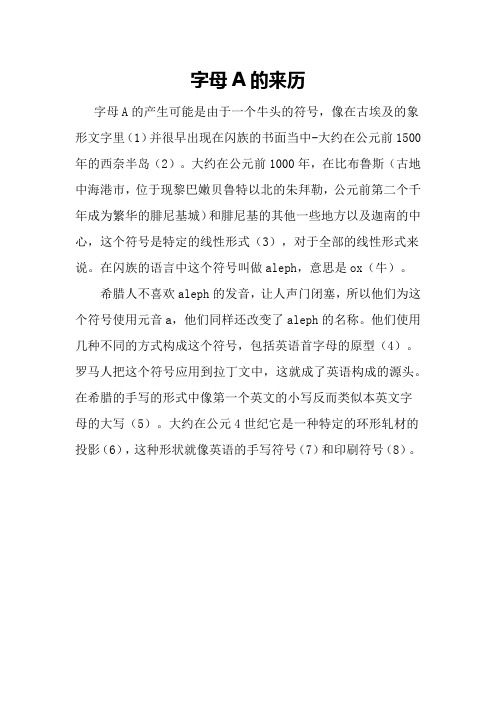
字母A的来历
字母A的产生可能是由于一个牛头的符号,像在古埃及的象形文字里(1)并很早出现在闪族的书面当中-大约在公元前1500年的西奈半岛(2)。
大约在公元前1000年,在比布鲁斯(古地中海港市,位于现黎巴嫩贝鲁特以北的朱拜勒,公元前第二个千年成为繁华的腓尼基城)和腓尼基的其他一些地方以及迦南的中心,这个符号是特定的线性形式(3),对于全部的线性形式来说。
在闪族的语言中这个符号叫做aleph,意思是ox(牛)。
希腊人不喜欢aleph的发音,让人声门闭塞,所以他们为这个符号使用元音a,他们同样还改变了aleph的名称。
他们使用几种不同的方式构成这个符号,包括英语首字母的原型(4)。
罗马人把这个符号应用到拉丁文中,这就成了英语构成的源头。
在希腊的手写的形式中像第一个英文的小写反而类似本英文字
母的大写(5)。
大约在公元4世纪它是一种特定的环形轧材的投影(6),这种形状就像英语的手写符号(7)和印刷符号(8)。
古埃及符号——精选推荐
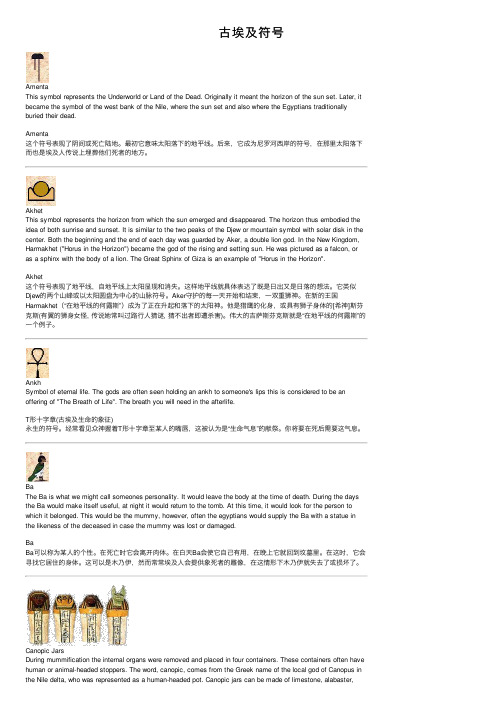
古埃及符号AmentaThis symbol represents the Underworld or Land of the Dead. Originally it meant the horizon of the sun set. Later, it became the symbol of the west bank of the Nile, where the sun set and also where the Egyptians traditionally buried their dead.Amenta这个符号表现了阴间或死亡陆地。
最初它意味太阳落下的地平线。
后来,它成为尼罗河西岸的符号,在那⾥太阳落下⽽也是埃及⼈传说上埋葬他们死者的地⽅。
AkhetThis symbol represents the horizon from which the sun emerged and disappeared. The horizon thus embodied the idea of both sunrise and sunset. It is similar to the two peaks of the Djew or mountain symbol with solar disk in the center. Both the beginning and the end of each day was guarded by Aker, a double lion god. In the New Kingdom, Harmakhet ("Horus in the Horizon") became the god of the rising and setting sun. He was pictured as a falcon, or as a sphinx with the body of a lion. The Great Sphinx of Giza is an example of "Horus in the Horizon".Akhet这个符号表现了地平线,⾃地平线上太阳显现和消失。
古埃及文字
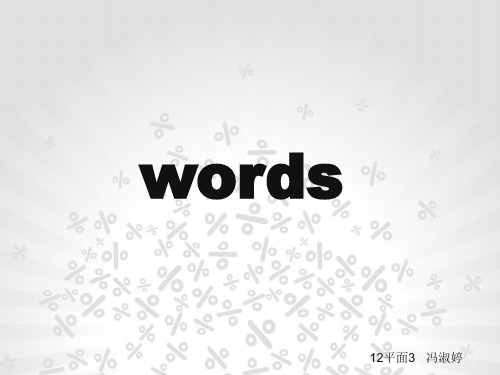
僧侣体在埃及早期王朝(Protodynastic Period)开始使用,但不是由 圣书体演变而成,因为没有圣书体字形的证据。圣书体用于石碑铭刻最早在 埃及第一王朝,那时候书吏已经使用僧侣体,可见两种文字在同一时期发展 而成。(但这种说法目前还有相当的争议) 僧侣体一直在古埃及时期和罗马统治时期使用。公元前660年世俗体 (Demotic)取代僧侣体,用来纪录非宗教事务。直至公元3世纪,僧侣 仍然使用僧侣体。僧侣体跟一般手写体不同,阅读方向从右到左。起初僧侣 体可以直书和横书,但在埃及第十二王朝后直书成为标准书写方法,除了可 避免书写时弄糟纸上其他文字和增加书写速度,也使阅读书卷更方便。
玛雅文化的形成,距今约公元前2500年 - 公元250年的岁月。在尤卡坦半 岛中央佩滕盆地及其周围山谷已出现定居的农业生活,玉米和豆类是主要的 作物;从地球站,祭坛和其他组件的早期祭祀中心也已经成立,有一个后续国 家萌芽状态,并出现了象形文字。
世界语言的分类方法也不尽相同。比较著名的有:
1.中国北京大学分类法 中国北京大学中文系教授徐通锵,胡吉成将世界语言分类为13个语系, 45个语族。这13个语系是:汉藏语系、印欧语系、高加索语系,乌拉尔 语系、阿尔泰语系、达罗毗荼语系、南亚语系、南岛语系、闪--含语系、 尼日尔—科尔多凡语系,尼罗---撒哈拉语系,科依桑语系,北美印第安语 系。 2. 英国Simon大学遗传学分类法 (1)欧亚语系,包括汉藏语系、印欧语系。 (2).太平洋和非洲语系,包括.除欧亚语系,南北美洲以外其他各国的语 言。 (3).北美语系:北美洲土著印第安语言。 (4).南美语系:南美洲土著印第安语言。
世界语言的分类标准一般有两个:
一是按结构分类,即以语言结构的特点来进行分类。 ⒈ 词汇附着型语言。这种语言的词用在句子里时,词形不表示语法关系 的形式,必须用其他词汇附着句子里,才能表达语法关系。如汉语中的时 间,必须加 · 现在,昨天,明天 等词汇才能表达。
教你认识各种宗教符号

教你认识各种宗教符号【宗教象征符号系列】大卫之星最早发现这个符号是在公元前800至600年。
在犹太人的王国传说犹太史上最杰出的国王"大卫"使用这种形状的藤牌, 南征北战, 打败了迦南地(今巴勒斯坦)的强敌非利士人, 统一了以色列12支派, 建立了强大的希伯来王国, 因此犹太人把这种六角形称作"大卫盾(MOGEN DAVID) "或"大卫星"。
【宗教象征符号系列】"十字架"是一个很古老的符号, 他有很多种类及丰富的含义, 此处只记述"基督教十字架"或称"拉丁十字架"。
【宗教象征符号系列】新月符号是伊斯兰教的标志, 但绝不是伊斯兰教的崇拜物, "穆斯林"(Muslim, 伊斯兰信徒,意为"顺从者")坚信"真主", 反对"以物配主"(陪伴真主)。
伊斯兰教相信"安拉"独一, 是大慈、大能、大智的, 他无形无像, 无时不在, 无处不在。
【魔法护身符系列】荷鲁斯之眼是一个自古埃及时代便流传至今的符号,也是古埃及文化中最令外人印象深刻的符号之一。
【宗教象征符号系列】"太极八卦图", 同时也是"道教"的象征符号. "太极八卦":由"太极"和"八卦"两部分组成组成。
"太极" 即为"天地未开、混沌未分、阴阳之前的状态"。
"两仪"即为" 太极的阴、阳二仪"。
【宗教象征符号系列】卐符号:“卐”是上古时代许多部落的一种符咒,在古代印度、波斯、希腊、埃及、特洛伊等国的历史上均有出现,后来被古代的一些宗教所沿用。
最初人们把它看成是太阳或火的象征,以后普遍被作为吉祥的标志。
五芒星——晴明桔梗印

五芒星——晴明桔梗印2010-08-07 15:05:34| 分类:神之語|字号订阅五芒星(Pentacle)在古埃及被作为冥界子宫的符号,而在古代巴比伦则被作为女神伊修塔尔的孪生姐姐尼斐提斯(冥界女神)的符号。
在希腊神话中,五芒星是大地女神Kore 的象征。
晴明神社的神纹被称作晴明桔梗印,是晴明公独创的阴阳道中祈祷咒符的一种,代表象征宇宙万物的天地五行(木火土金水)之无灾无邪。
凯尔特人将五芒星作为冥界女神摩根的象征,在凯尔特传说中,太阳英雄加温为了向女神表达敬意而在自己血红的盾牌上画了五芒星。
毕达格拉斯学派的神秘主义者也崇拜这个符号,将它称为“五回交错的诞生(文字)”。
因此,在神秘学中,尖角向上的五芒星代表者“生命”和“健康”,被用作祈求幸福的魔法符号,也被作为守护符和治疗伤病的符号。
古代巴比伦人甚至将五芒星绘制在食物的容器上,认为这样就可以保鲜;而巴比伦的七个印章中,第一个神圣的纹章就是五芒星。
犹太教的经典中认为,这些印章代表了神的秘密的名字,五芒星就是其中最重要的一个,所以中世纪术士杜撰的“所罗门王的魔法戒指”上也刻有五芒星,也因为如此,五芒星也被误传为“所罗门的印章”。
而五芒星也出现在天使米达伦(Metatron)的封印上,这个符号包括圆形魔法阵、五芒星和咒语。
中世纪炼金术士绘制的所谓小宇宙模型(人体模型)中,外部的圆圈代表宇宙,内部绘有一名男性像,头部、双手和双足各对应五芒星的五个角,生殖器位于圆心。
因此,术士们认为人的“小宇宙”(可参考“生命之树”)由五星支配。
由于五芒星可以一笔画出,因此古人也迷信它可以防止恶魔和恶灵的侵犯。
在神秘学的魔法阵中,圆形魔法阵用于保护魔法师本人,而五芒星则被用于封印恶魔、其线条的五个交汇点被认为是可以封闭恶魔的“门”,可以将恶魔封在五芒星中间的五边形中。
因此,教会将五芒星称为“恶魔的纹章”、“女巫的十字”、“魔法师之星”和“女巫之足”,甚至宣称人狼的脚后跟就有五芒星。
世界上的十大神秘符号
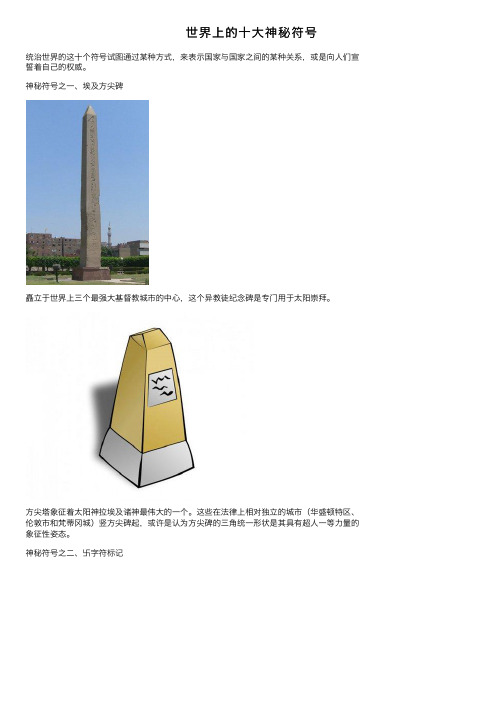
世界上的⼗⼤神秘符号统治世界的这⼗个符号试图通过某种⽅式,来表⽰国家与国家之间的某种关系,或是向⼈们宣誓着⾃⼰的权威。
神秘符号之⼀、埃及⽅尖碑矗⽴于世界上三个最强⼤基督教城市的中⼼,这个异教徒纪念碑是专门⽤于太阳崇拜。
⽅尖塔象征着太阳神拉埃及诸神最伟⼤的⼀个。
这些在法律上相对独⽴的城市(华盛顿特区、伦敦市和梵蒂冈城)竖⽅尖碑起,或许是认为⽅尖碑的三⾓统⼀形状是其具有超⼈⼀等⼒量的象征性姿态。
神秘符号之⼆、卐字符标记希特勒的纳粹党采⽤这个符号之前,它已经在西欧经历了⼀次长达⼏⼗年的流⾏,因为象征好运和财富,所以希特勒希望借助它来为纳粹党积聚⼈⽓。
事实上,早在公元前4000-10000年的物体上就发现有卐字饰。
印度河流域⽂明的印度教、佛教和耆那教等宗教仍然使⽤这⼀符号表⽰神圣吉祥或太阳射线。
在佛教中,⼀些⼈认为在佛祖⼊葬时,其胸部烙有⼀个这种符号,称为⼼印。
神秘符号之三、⼗字架在基督教将⼗字架当成其象征之前,它对于太阳神来说是⼀个异教符号,表⽰男性和⼥性能量的完美结合。
(最初的⼗字架的轴长度⼀样)。
教皇还佩戴原先的那种⼗字架,当你认为基督徒尊崇耶稣是上帝之⼦时,这样做才算讲得通。
罗马皇帝康斯坦丁是⼀个奉⾏太阳崇拜的异教徒,所以罗马帝国才将基督教作为其主要宗教,因此将⼗字架作为其主要符号或许就绝⾮巧合了。
神秘符号之四、⼤卫之星六⾓星⽬前是以⾊列的⾸要象征,代表着⼤卫盾,然⽽其起源远⽐公元1018年要早得多,⼈们发现那时就有犹太⼈使⽤六⾓星的最初记载。
⼤卫之星可以追溯数千年的南印度寺庙中有六⾓星(⼀些旁边有卍字饰)装饰其外表。
印度教徒将六⾓星尊为曼荼罗并⽤它来代表⼼轮。
在古书《西藏度亡经》中,六⾓星内有⼀个卐字饰的图型,代表宇宙中的创造⼒。
如果希特勒试图将犹太⼈视为邪恶,他肯定⽤错了符号。
世界各地有10多个宗教使⽤六⾓星,⼀直⽤以代表⼀种正⾯或强⼤的本义。
神秘符号之五、穆斯林新⽉虽然使⽤神圣符号违反穆斯林法律,新⽉还是成为⼏个穆斯林国家旗帜上的旗饰并被采⽤成为伊斯兰信仰的⾮正式象征。
古埃及计数符号和书写方法

古埃及计数符号和书写方法嘿,你知道吗?古埃及那可是个充满神秘色彩的地方呀!他们的计数符号和书写方法那可真是别具一格呢!古埃及人用的计数符号就像是一个个独特的小图案,形象又有趣。
比如说,一根竖线就代表着 1,是不是很简单直接呀?那要是好多根竖线排在一起,不就代表了好多 1 嘛!还有像个拱起的小石桥似的符号代表着 10,嘿,这多有意思呀!想象一下,他们就用这些简单又特别的符号,进行着各种计算和记录呢。
再说说书写方法,那也是很有特色嘞!古埃及人写在莎草纸上,那莎草纸就像是他们的魔法画布。
他们的字呀,有的像小鸟,有的像小鱼,各种各样的形状,可生动啦!而且呀,他们写字可不是从左到右或者从右到左那么简单,有时候是从上到下,有时候又是从下到上,甚至还会绕来绕去的,就像在纸上跳舞一样,神奇吧?这些计数符号和书写方法,可不是随随便便就有的哦!那是古埃及人经过长时间的摸索和实践才形成的呢。
这就好像我们现在学的数学和语文一样,都是一点点积累起来的呀。
你想想,在那个没有电脑和手机的年代,古埃及人靠着这些计数符号和书写方法,记录着他们的生活、历史和文化。
他们用这些符号来记录粮食的数量,记录战争的胜负,记录国王的功绩。
这是多么了不起的事情呀!而且哦,这些古埃及的计数符号和书写方法,对后来的文明也产生了深远的影响呢。
就好像一颗种子,在历史的长河中生根发芽,长出了茂密的枝叶。
咱再回过头来看看现在,我们的计数和书写方法虽然和古埃及的大不相同,但我们也不能忘了他们的贡献呀。
这就像是我们不能忘了自己的老祖宗一样,要心怀敬意和感激呢。
总之呢,古埃及的计数符号和书写方法,那真的是人类文明的瑰宝呀!它们让我们看到了古人的智慧和创造力,也让我们更加珍惜现在所拥有的一切。
你说是不是呀?难道你不想去深入了解一下这些神奇的符号和方法吗?相信你了解过后,肯定也会被古埃及人的智慧所折服的!。
神秘的古代符号
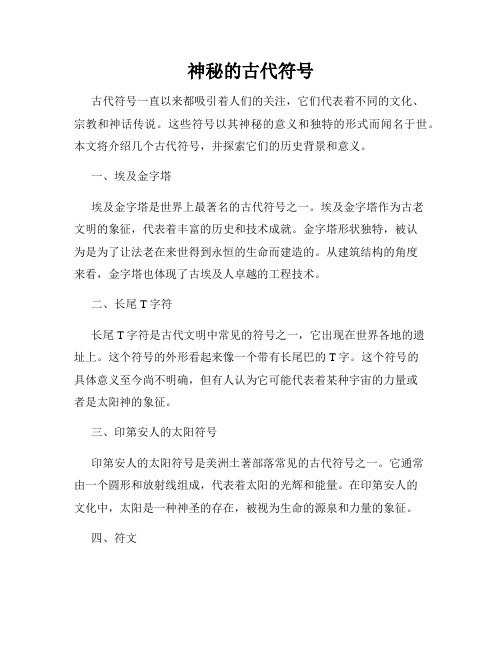
神秘的古代符号古代符号一直以来都吸引着人们的关注,它们代表着不同的文化、宗教和神话传说。
这些符号以其神秘的意义和独特的形式而闻名于世。
本文将介绍几个古代符号,并探索它们的历史背景和意义。
一、埃及金字塔埃及金字塔是世界上最著名的古代符号之一。
埃及金字塔作为古老文明的象征,代表着丰富的历史和技术成就。
金字塔形状独特,被认为是为了让法老在来世得到永恒的生命而建造的。
从建筑结构的角度来看,金字塔也体现了古埃及人卓越的工程技术。
二、长尾T字符长尾T字符是古代文明中常见的符号之一,它出现在世界各地的遗址上。
这个符号的外形看起来像一个带有长尾巴的T字。
这个符号的具体意义至今尚不明确,但有人认为它可能代表着某种宇宙的力量或者是太阳神的象征。
三、印第安人的太阳符号印第安人的太阳符号是美洲土著部落常见的古代符号之一。
它通常由一个圆形和放射线组成,代表着太阳的光辉和能量。
在印第安人的文化中,太阳是一种神圣的存在,被视为生命的源泉和力量的象征。
四、符文符文是古代北欧文明中广泛使用的一种文字系统。
这些符号以其独特的形状和设计风格而闻名,并在北欧神话中起到重要的角色。
符文被用于神秘的仪式和咒语中,被认为具有神奇的力量和保护作用。
如今,符文仍然被一些人用作装饰品,以展示对北欧传统和文化的热爱。
五、玛雅人的日历符号玛雅人的日历符号是古代中美洲玛雅文明中使用的一种符号系统。
玛雅人对时间的测量非常准确,他们开发了复杂的日历系统,并使用一系列符号来表示不同的日期和事件。
这些符号的纹理错综复杂,被认为代表着玛雅人丰富的宇宙观和神话传说。
综上所述,古代符号承载着丰富的历史和文化内涵。
从埃及金字塔到玛雅人的日历符号,每个古代符号都代表着不同的文明和神秘的力量。
虽然我们对某些符号的意义仍然一知半解,但它们依然能够吸引着人们的好奇心,让我们思考和探索古代文明的奥秘。
古人的记事符号

古人的记事符号
古代各国记数符号如下:
1. 中国古代:
用打结的绳子来记数,用小石子记成“一一”,用算筹记成“一│”,表示一个。
2. 古印度:
记数符号为“├”,表示2;记数符号为“┤”,表示3;记数符号为“┴”,表示10。
3. 古巴比伦:
记数符号为“”,表示1;记数符号为“││││││││││”,表示10;记数符号为“│││││││││││││││││││││││││”,表示100。
4. 古埃及:
记数符号为“”,表示1;记数符号为“”,表示10;记数符号为“”,表示100。
5. 古希腊:
记数符号为“Ι”,表示1;记数符号为“Ⅱ”,表示2;记数符号为“Ⅲ”,表示3。
6. 古罗马:
记数符号为“Ⅰ”,表示1;记数符号为“Ⅱ”,表示2;记数符号为“Ⅲ”,表示3。
7. 古玛雅:
记数符号为“”,表示1;记数符号为“”,表示5;记数符号为“”,表示20。
8. 古苏美尔:
记数符号为“”,表示1;记数符号为“”,表示10;记数符号为“”,表示100。
9. 古阿拉伯:
记数符号为“”,表示1、2、3、4、5、6、7、8、9、0。
10. 古希腊罗马:
记数符号为“ⅠⅡⅢⅣⅤⅥⅦⅧⅨⅩⅪⅫ”,表示1、2、3、4、5、6、7、8、9、10、11、12。
古埃及的象形文字与文字解读
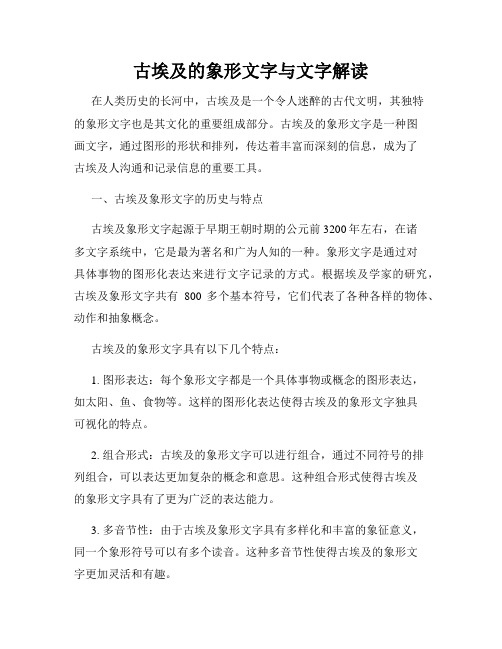
古埃及的象形文字与文字解读在人类历史的长河中,古埃及是一个令人迷醉的古代文明,其独特的象形文字也是其文化的重要组成部分。
古埃及的象形文字是一种图画文字,通过图形的形状和排列,传达着丰富而深刻的信息,成为了古埃及人沟通和记录信息的重要工具。
一、古埃及象形文字的历史与特点古埃及象形文字起源于早期王朝时期的公元前3200年左右,在诸多文字系统中,它是最为著名和广为人知的一种。
象形文字是通过对具体事物的图形化表达来进行文字记录的方式。
根据埃及学家的研究,古埃及象形文字共有800多个基本符号,它们代表了各种各样的物体、动作和抽象概念。
古埃及的象形文字具有以下几个特点:1. 图形表达:每个象形文字都是一个具体事物或概念的图形表达,如太阳、鱼、食物等。
这样的图形化表达使得古埃及的象形文字独具可视化的特点。
2. 组合形式:古埃及的象形文字可以进行组合,通过不同符号的排列组合,可以表达更加复杂的概念和意思。
这种组合形式使得古埃及的象形文字具有了更为广泛的表达能力。
3. 多音节性:由于古埃及象形文字具有多样化和丰富的象征意义,同一个象形符号可以有多个读音。
这种多音节性使得古埃及的象形文字更加灵活和有趣。
二、古埃及象形文字的应用与解读古埃及象形文字在古埃及文化中发挥了重要作用,应用于各个领域,包括宗教、政治、文学、历史等。
通过对古埃及象形文字的解读,我们可以更好地了解古埃及人的生活和思想。
1. 宗教用途:古埃及的象形文字在宗教仪式和祭祀活动中得到广泛应用。
例如,太阳的象形符号在古埃及的宗教信仰中代表着太阳神,其它的符号如锥形符号则代表着神秘和神圣。
2. 政治记录:古埃及的象形文字被用于记录国家事务和政治事件。
古埃及的法典《爱德文书法典》就是一个包含大量象形文字的例子,它详细记录了古埃及的法律和制度。
3. 文学创作:古埃及的象形文字在文学创作中发挥着重要的作用。
古埃及的诗歌、神话和寓言故事等文学作品中使用了丰富的象形符号来表达和补充文本的意义。
数学符号知识
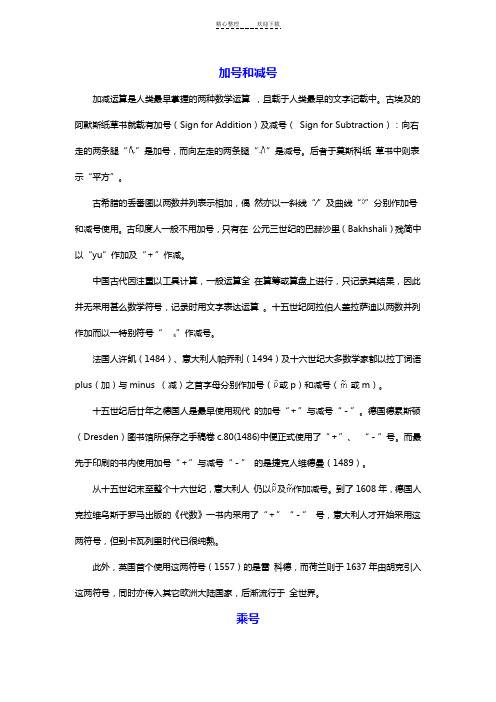
加号和减号加减运算是人类最早掌握的两种数学运算,且载于人类最早的文字记载中。
古埃及的阿默斯纸草书就载有加号(Sign for Addition)及减号(Sign for Subtraction):向右走的两条腿“”是加号,而向左走的两条腿“”是减号。
后者于莫斯科纸草书中则表示“平方”。
古希腊的丢番图以两数并列表示相加,偶然亦以一斜线“∕”及曲线“”分别作加号和减号使用。
古印度人一般不用加号,只有在公元三世纪的巴赫沙里(Bakhshali)残简中以“yu”作加及“+”作减。
中国古代因注重以工具计算,一般运算全在算筹或算盘上进行,只记录其结果,因此并无采用甚么数学符号,记录时用文字表达运算。
十五世纪阿拉伯人盖拉萨迪以两数并列作加而以一特别符号“s”作减号。
法国人许凯(1484)、意大利人帕乔利(1494)及十六世纪大多数学家都以拉丁词语plus(加)与minus (减)之首字母分别作加号(或p)和减号(或m)。
十五世纪后廿年之德国人是最早使用现代的加号“+”与减号“-”。
德国德累斯顿(Dresden)图书馆所保存之手稿卷c.80(1486)中便正式使用了“+”、“-”号。
而最先于印刷的书内使用加号“+”与减号“-”的是捷克人维德曼(1489)。
从十五世纪末至整个十六世纪,意大利人仍以及作加减号。
到了1608年,德国人克拉维乌斯于罗马出版的《代数》一书内采用了“+”“-”号,意大利人才开始采用这两符号,但到卡瓦列里时代已很纯熟。
此外,英国首个使用这两符号(1557)的是雷科德,而荷兰则于1637年由胡克引入这两符号,同时亦传入其它欧洲大陆国家,后渐流行于全世界。
乘号乘法(Multiplication)亦是最早产生的运算之一,且出现于人类最早的文字记载当中。
中国古人及古希腊的丢番图都不用乘号(Signs of multiplication),但后者则以两数并列表示相乘(与加法相同)。
印度的巴赫沙里残简中,把数排成表示;排成表示x x施蒂费尔于1545年出版的一本算术书内以大写字母M及D分别表示乘和除。
圆圈十字符号

圆圈十字符号
圆圈十字符号是一种古老而历史悠久的符号,象征着新生、回归、融合等深刻的思想。
它既是一种理念,更是一种审美观,被广泛运用于社会、宗教、艺术、哲学和文化等各个领域。
圆圈十字符号的起源可以追溯到古埃及文明,在枯燥乏味的埃及远古墓室中,便可以发现其蛛丝马迹。
而随着时间的流逝,这一符号被许多古文明所采用,如中国和印度等,成为宗教、哲学和文化传统的重要标志。
圆圈十字符号分为内外两部分,外部是一圆,代表无限与永恒,里面是一个十字,表示四个方面的交汇,延伸为许多方向,灵感无穷。
古人将圆圈十字符号称为“万事万物的根基”,对它的理解不仅局限于形象字面的意义上,更引申出它深层次的象征意义。
圆圈十字符号是不同文明尊崇的一种图腾,在人们生活中,它被用作宗教神器,也被赋予深刻的精神内涵,象征着新生、回归、完美、净化和融合等各种深远的意义。
从全球的角度来看,它的意义和价值更是被赞誉且不可或缺。
同时,圆圈十字符号也被用作美术和艺术的素材,它不仅被西方的现代艺术家们所推崇,而且也被中国的传统艺术家们所采用,用以表现出自然美丽、朴实无华的艺术精髓,它融入了中国艺术的传统元素,形象地表达了人们追求宇宙伟大、物质生活完美和精神自由的理想。
圆圈十字符号博大精深,无论从历史文化还是审美审科学的角度
来讲,都体现着它的重要性与普遍性,它的出现和流传,极大地丰富了人们的审美情趣,是一种不可多得的精神宝藏,拥有着无限的魅力。
综上所述,圆圈十字符号无疑是一种宝贵的历史古迹,它不仅是理念,更是一种审美观,历经岁月的洗礼,继续流传至今。
它象征着新生、回归、融合等深刻的思想,赋予人们宏伟辽阔的精神,激发人们前行的探索热情,且深深吸引着世世代代的人们。
古埃及艺术与宗教符号的研究

古埃及艺术与宗教符号的研究古埃及文明是世界历史上最古老、最丰富、最引人入胜的文明之一,其艺术与宗教符号在人类的历史长河中占据了重要的位置。
古埃及艺术以其独特的风格和丰富的象征意义而闻名于世,这些艺术品如墓室壁画、石雕、石棺等,不仅展现了古埃及人民的生活和思想,还传达了丰富的宗教观念与信仰。
古埃及的艺术作品常常是在宗教背景下创作的,它们既是对宗教信仰的表达,也是用于仪式和祭祀的工具。
这一点在墓室壁画上体现得尤为明显。
墓室壁画是古埃及人为死者而创作的壁画,其目的是帮助死者在来世中获得永恒的生命。
墓室壁画中的人物和场景常常是与宗教信仰相关的,如太阳神拉与死者一同进入来世的画面,以及死者在来世中生活和工作的描绘。
这些壁画传达了古埃及人民对来世的向往,也揭示了他们对死者的尊重与怀念。
古埃及艺术中常见的一种重要符号是“ankh”,也被称为“生命之符”。
这个符号由一个十字形的顶端和一个圆圈形的底端组成,代表着生命的永恒循环和不朽的力量。
在古埃及的神话和信仰中,生命是众神的馈赠,而死亡只是生命循环中的一个过渡。
因此,“ankh”符号常常被描绘在墓碑、墓室壁画中,表示死者在来世中能够获得永恒的生命。
同时,“ankh”符号还被用于祭祀的仪式中,作为神圣的象征,以增加仪式的权威和效果。
除了“ankh”符号,古埃及艺术中还有许多其他宗教符号,其中最著名的是“乌鸦头象”的雕刻。
这是古埃及墓穴中最常见的艺术形象之一,它是埃及神话中的神祇乌鸦的头部形象。
乌鸦是埃及神话中的“智慧之神”,代表着人类的智慧和知识,也是守护者和指引者。
在古埃及的宗教仪式和祭祀中,乌鸦头象通常被放置在祭坛或神庙的入口处,象征着神灵的庇佑和保护。
古埃及艺术与宗教符号的研究从人类学和考古学的角度提供了深入的洞察。
通过对古埃及艺术作品的研究,我们可以了解古埃及社会的宗教信仰、价值观和文化传统。
古埃及人民对来世的向往和对永恒生命的追求,体现了他们对生命和死亡的独特理解,也揭示了他们对死者的尊重和怀念。
e和o的区别在于

e和o的区别在于
o与e的主要区别在于:o是圆唇音,e是不圆唇音。
字母E的产生可能是由于一个双手举起的人的符号,像在古埃及的象形文字里并很早出现在约在公元前1500年的西奈半岛。
这个符号对于埃及人来说是快乐或者高兴的意思。
大约在公元前1000年,在比布鲁斯(古地中海港市,位于现黎巴嫩贝鲁特以北的朱拜勒,公元前第二个千年成为繁华的腓尼基城)和腓尼基的其他一些地方以及迦南的中心,这个符号是特定的线性形式,对于全部的线性形式来说。
这个符号在闪族的语言里叫做he就像英语中H的发音。
当希腊人开始从左到右书写的时候他们从中间翻转了这个符号使它容易书写。
他们否定了闪族人h的标准并且给了它一个新的标准-元音e。
他们叫这个符号为epsilon,意味着short e(简略的e)。
罗马人采用了这个符号作为拉丁文中的大写字母E。
而这个符号又毫无改变的从拉丁文中应用到了英语中。
希腊罗马时代的书写改变了字母使得它更适用于书写。
到了这个时候英语的手写体和印刷体就成了小写e。
1。
- 1、下载文档前请自行甄别文档内容的完整性,平台不提供额外的编辑、内容补充、找答案等附加服务。
- 2、"仅部分预览"的文档,不可在线预览部分如存在完整性等问题,可反馈申请退款(可完整预览的文档不适用该条件!)。
- 3、如文档侵犯您的权益,请联系客服反馈,我们会尽快为您处理(人工客服工作时间:9:00-18:30)。
AmentaThis symbol represents the Underworld or Land of the Dead. Originally it meant the horizon of the sun set. Later, it became the symbol of the west bank of the Nile, where the sun set and also where the Egyptians traditionally buried their dead.阿门塔这个符号表现了阴间或死亡陆地。
最初它意味太阳落下的地平线。
后来,它成为尼罗河西岸的符号,在那里太阳落下而也是埃及人传说上埋葬他们死者的地方。
AkhetThis symbol represents the horizon from which the sun emerged and disappeared. The horizon thus embodied the idea of both sunrise and sunset. It is similar to the two peaks of the Djew or mountain symbol with solar disk in the center. Both the beginning and the end of each day was guarded by Aker, a double lion god. In the New Kingdom, Harmakhet ("Horus in the Horizon") became the god of the rising and setting sun. He was pictured as a falcon, or as a sphinx with the body of a lion. The Great Sphinx of Giza is an example of "Horus in the Horizon".Akhet这个符号表现了地平线,自地平线上太阳显现和消失。
这样地平线就具体表达了既是日出又是日落的想法。
它类似Djew的两个山峰或以太阳圆盘为中心的山脉符号。
Aker守护的每一天开始和结束,一双重狮神。
在新的王国Harmakhet(“在地平线的何露斯”)成为了正在升起和落下的太阳神。
他是猎鹰的化身,或具有狮子身体的[希神]斯芬克斯(有翼的狮身女怪, 传说她常叫过路行人猜谜, 猜不出者即遭杀害)。
伟大的吉萨斯芬克斯就是“在地平线的何露斯”的一个例子。
[女尸注:洪水季(Akhet)、冬季(播种季,Peret)和夏季(收获季,Shemu)。
不知有何关系]AnkhSymbol of eternal life. The gods are often seen holding an ankh to someone's lips this is considered to be an offering of "The Breath of Life". The breath you will need in the afterlife.T形十字章(古埃及生命的象征)永生的符号。
经常看见众神握着T形十字章至某人的嘴唇,这被认为是“生命气息”的献祭。
你将要在死后需要这气息。
BaThe Ba is what we might call someones personality. It would leave the body at the time of death. During the days the Ba would make itself useful, at night it would return to the tomb. At this time, it would look for the person to which it belonged. This would be the mummy, however, often the egyptians would supply the Ba with a statue in the likeness of the deceased in case the mummy was lost or damaged.BaBa可以称为某人的个性。
在死亡时它会离开肉体。
在白天Ba会使它自己有用,在晚上它就回到坟墓里。
在这时,它会寻找它居住的身体。
这可以是木乃伊,然而常常埃及人会提供象死者的雕像,在这情形下木乃伊就失去了或损坏了。
Canopic JarsDuring mummification the internal organs were removed and placed in four containers. These containers often have human or animal-headed stoppers. The word, canopic, comes from the Greek name of the local god of Canopus in the Nile delta, who was represented as ahuman-headed pot. Canopic jars can be made of limestone, alabaster, wood, pottery, or even cartonnage.有罩盖的罐在木乃伊化期间内脏被摘除放进四个容器内。
这些容器经常具有人或动物头形的塞子。
有罩盖的这个词,从在尼罗河三角洲本地Canopus神希腊名称演变而来,她是以人头形罐那样去表现。
有罩盖的罐可以由石灰石、石膏、木头、陶器、甚至是cartonnage做成。
The heads of the canopic jar represented the Four Sons of HorusFrom left to right they are;有罩盖的罐头表现了何露斯四个儿子,从左至右他们是;Imsety: The human headed guardian of the liver姆塞提: 守护肝脏人头形Qebekh-sennuef: The falcon headed guardian of the intestines.Qebekh-sennuef: 守护肠脏猎鹰头形Hapy: The baboon headed guardian of the lungs哈比: 守护肺的狒狒头形Duamutef: The jackal or wild dog headed guardian of the stomach.杜米特夫: 守护胃的豺或野狗头形Cartouche - ShenuMore commonly know as a cartouche. The shape represents a loop of rope in which a name is written. A protector of that name.椭圆形轮廓- Shenu普遍认为是椭圆形轮廓。
形状表现了一条绳圈,在绳圈里写有一个名称。
名称的保护者。
Crowns王冠HedjetThe White Crown. This was the crown of Upper Egypt (southern).Hedjet白色王冠。
这个是上埃及(南部的)。
PshentThe Double Crown, the red crown and the white crown put together to represent a unified Egypt.Although Egypt was not always a unified nation it was stronger that way.Therefore unification was desirable. Narmer (Menes), the founder of the First Dynasty around 3100 B.C., was the first man recorded wearing this crown.Pshent双王冠,红王冠和白王冠加在一起表现统一的埃及。
尽管埃及不总是一个一体化国家,那样它更强大。
因此统一是合乎愿望的。
Narmer(美尼斯,埃及统一后第一代国王),大约公元前3100年第一王朝的创建者,已记录的戴这王冠的第一人。
AtefThe atef crown was worn by Osiris. It is made up of the white crown of Upper Egypt and the red feathers are representative of Busiris, Osiris's cult center in the Delta.阿特夫由奥斯里斯(司阴府之神, 地狱判官古埃及的主神之一)穿戴这atef王冠。
它是由上埃及的白王冠和代表Busiris红色羽毛制成,奥斯里斯祭仪中心在三角洲德耳塔(希腊字母的第四个字)。
KhepreshThe blue crown was a ceremonial crown often worn in battle.Khepresh蓝色王冠是一仪式王冠,经常在战争中穿戴。
DeshretThe Red Crown. This was the crown that represented Lower Egypt (northern).Deshret红色王冠。
这是表现下埃及的王冠(北方的)。
DjewWhich means mountain, the symbol suggests two peaks with the Nile valley in the middle. The Egyptians believed that there was a cosmic mountain range that held up the heavens. This mountain range had two peaks, the western peak was called Manu, while the eastern peak was called Bakhu. It was on these peaks that heaven rested. Each peak of this mountain chain was guarded by a lion deity, who's job it was to protect the sun as it rose and set. The mountain was also a symbol of the tomb and the afterlife, probably because most Egyptian tombs were located in the mountainous land bordering the Nile valley. In some texts we find Anubis, the gaurdian of the tomb being referred to as "He who is upon his mountain." Sometimes we find Hathor takeing on the attributes of a deity of the afterlife, at this time she is called "Mistress of the Necropolis." She is rendered as the head of a cow protruding from a mountainside.Djew意味山,符号用尼罗河中部的山谷暗示两个山峰。
